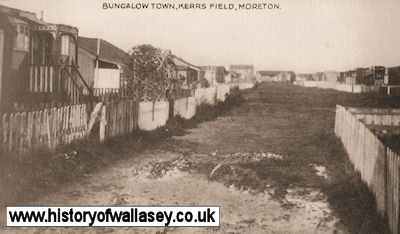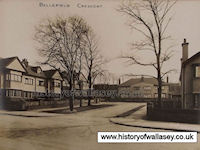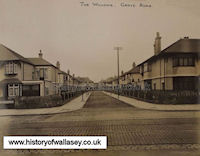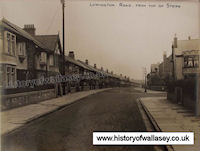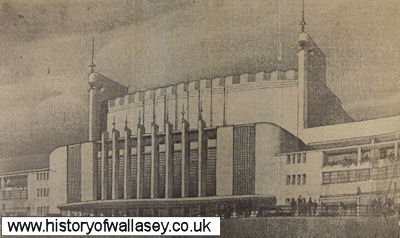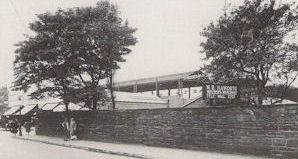Wallasey In The
Post War Years
1918 - 1939
The Origin and Development of the Moreton "Caravan-Town"
The following Population Census returns for the Parish of Moreton are very helpful in understanding the origin and growth of the "Caravan-Town".
Year |
Population |
Increase or Decrease |
1801 |
210 |
|
1811 |
230 |
20 |
1821 |
273 |
43 |
1831 |
247 |
-26 |
1841 |
330 |
83 |
1851 |
350 |
20 |
1861 |
351 |
11 |
1871 |
455 |
94 |
1881 |
424 |
-31 |
1891 |
464 |
40 |
1901 |
597 |
122 |
1911 |
989 |
392 |
1921 |
4,029 |
3.040 |
1925 |
9,082 |
5,053 |
From these figures, it will be seen that the population, although doubling itself during the century, remained exceedingly small until the early years of the last century. Clearly then, Moreton remained a quiet, rural, agricultural community outside the sphere of influence of the Merseyside conurbation. At the start of the twentieth century conditions began to change.
In 1900, the Corporation of Birkenhead acquired control of Leasowe Common and in the years following people were permitted to live there in tents during the summer months of the year. These people, coming mainly from the poorer quarters of Birkenhead, naturally derived great benefit from living in the fresh air. Unfortunately the strong winds blowing over the Common caused many people to erect bungalows from 1907 onwards. These bungalows were erected on the understanding that they would be removed when the Wirral Rural District Council so requested.
Under these arrangements the number of bungalows increased until 1913 when complaints began to arise concerning the unsanitary conditions of some of them and the Rural District Council decided to serve notices upon all the bungalow owners requesting that they should be moved. Considerable opposition was raised and in subsequent litigation the bungalow owners won the test case, that of Kerr's Field. This was exceedingly unfortunate for since then the judgement given in that particular "has been looked upon by the bungalow owners as something like a charter of freedom". Further litigation followed and then the war years of 1914-1918 left conditions at a standstill.
In the immediate post-war years, the acute housing scarcity on Merseyside resulted in many people following the example set by the post-war summer bungalow dwellers at Moreton and Leasowe, only in their case, the dwellings were permanent habitants The influx of people was facilitated by the sale in 1918 of two very large farms in Moreton to land speculators who, in turn, disposed of them in the form of small plots.The consequences were disastrous. They are well described by Sir. Lynden Macassey in his evidence of the 1927 Enquiry before the house of Lords Committee, extracts from which follows:-
"There became a perfect influx into Moreton of furniture vans, caravans, railway carriages, shacks, and every kind of structure in which a man could live ..... This is what happened, and they exist in hundreds and hundreds. A man would bring a caravan or a furniture van, measuring 6 feet in width and probably 12 feet in length, and in that five and six and seven and up to ten and twelve persons have been permitted to live ..... One of the worst factors was a complete absence of any sanitary conveniences ..... The denizens of these structures ..... Simply disposal of their slop water by throwing it over the ground around and no attempt was made to dispose of the refused and garbage which accumulated ..... The results is that the sanitary conditions of a great part of Moreton are really indescribable ..... and the result of these sanitary conditions is to produce social conditions of the most regrettable character ..... Many of the roads ..... are nothing more than churned-up earth and it is impossible to walk along many of them without going over the boot deep in the mud, and, what is worst than the mud, the foul water and filth which is allowed to accumulate on these roads as a result of insufficient drainage being provided ..... Actually some of the roads are made up with ashpit refuse, with garbage, so much so that on some of them you can only pick your way as a result of considerate persons who have placed large stones here and there and bits of wood from which you can step in the course of your progress. Until quite recently (1925) no lighting whatever was provided for the whole of this district; there was not even one single public oil-lamp in a district with something like 8,000 persons and an important district, too" |
Later, in the evidence submitted to the Committee, extracts were quoted from the 1925 Reports of the Wallasey and Wirral Medical Officers which revealed even more vividly the state of affairs existing in that year. Parts of these extracts are well worth repetition:-
"Moreton demands special treatment in any health report which deals with N.W. Cheshire, not only because it has championed a retrogression to mediaeval conditions, but also because the failure of its experiments must be obvious to all who think" "If the vital statistics of Moreton are as favourable as reported, Moreton stands as a unique example of the value of light and air in the preservation of health; for if we exclude the influence of light and outside air in my view the worst slum in any large town in all other respects compares very favourably with a large number of the caravans in Moreton; and if there is the urgent necessity to clear away the majority of the caravans". |
Later in his report, the Wallasey Medical Officer of Health goes on to describe the condition of one of the worst fields in the following words:-
"It contained some 150 bungalows in all stages of disrepair, bounded on one side by a foul smelling stench perhaps 2 feet deep, on another by a ditch of about the same depth filled with stagnant water; all absolutely unprotected and crossed by planks in two places. The main places between the bungalows called by courtesy paths were simply churned up and with planks here and there they cross the most perilous parts. Some of the bungalows were actually standing in pools of foul water, while the water had disappeared below others leaving a filthy mud behind. In two spots were placed in the midst of a mass of bungalows the closet accommodation provided for their use. This consisted of whitewashed dilapidated enclosures made of rusty, decayed galvanised iron and wood. In one part of the enclosure, with a concrete floor containing many holes, were placed side by side four pail closets about 2 feet 6 high and therefore, totally unsuitable for children; and immediately behind and within the same curtilage compounds, there were deposited large bumps of petrifying matter of all hints, including human excreta. How such a state of affairs is allowed to exist in the 20th Century is beyond comprehension, and unless one had actually seen, one can hardly believe it possible". These were the conditions that existed in the period prior to the absorption of the area by Wallasey. The Bill for extension was first proposed and rejected by a poll of the rate-payers in 1925 but on the revival two years later, there was a slight majority in favour of the Bill and, in spite of consideration opposition from the Wirral Rural District Council and others, the Bill became law on 22nd December, 1927. Soon after much was done to improve the conditions. Roads were constructed, bridges were built over streams, sewers and drainage mains were laid-out and most of all, most of the caravans and bungalows had been removed (2,000 in the first 5-years). The removal of the caravans and bungalows necessitated the putting into operation of various housing schemes both by Corporation and private enterprise. Accordingly, the Council purchased building sites and erected 200 parlour houses in the Reeds Lane area with a further 322 houses, mostly of non-parlour type, on the Pasture Road site. To these Corporation houses must be added the number of houses of varying sizes built by private enterprises to suit tenants or owners of all classes. Up-to-date these total 487 houses. Many of these houses were built in small scattered groups but three compactly-built areas should be noticed as follows :-
All these houses were erected under Town-Planning agreements with the Corporation at the maximum rate of 12 houses per acre. Meanwhile, further building schemes were carried out on the eastern part of Wallasey. The Corporation Housing Schemes were particularly important and consisted of the following :-
The private building estates vary in size from small ones of 10-50 houses to big ones with 100-250 or more houses. The small areas mainly represent either small vacant patches of land here and there amongst the built-up area or else the sites of large houses which have been demolished. Examples of the former type are as follows :-
Housing Estates of the latter type ie. sites of large houses and their extensive grounds, include the following :-
The remaining estates, chiefly large ones, were built mostly on the open land west of the main built-up area, ie. west of the line running along Rolleston Drive, Belvidere Road, Torrington Road, Woodstock Road, Oxton Road and Gorsey Lane. the following are the larger estates :-
The majority of these houses were built 12 to the acre, the outstanding exception being the Gorsey Lane Estate. This Estate, situated in the southern part of Wallasey near the industrial zone, consisted of working-class houses with a density of 18 per acre.
Over the next few years further estates were built in Green Lane, Leasowe Road and Reeds Lane, as well as over a great part of Moreton. Accordingly, the control vested in the Local Authority by the recent Town Planning Acts became important in the preservation of amenities and the provisions of roads, open-spaces and the like.
The Post-War Development of New Brighton The Wallasey Corporation Bill of 1927 not only included the extension of the Borough boundaries, it gave the Local Authority power to proceed with the construction pf promenades and the related Baths and Boating Lake that made a marked difference in the importance of New Brighton as a sea-side resort. These changes inaugurated a new era in the life of the northern part of the Borough.
The general statistics show that for the five seasonal months of the year, May to September, the average number of ferry passengers is 750,000 per month means that approximately 275,000 enter the district as "trippers", the regular daily passengers as contract holders being in addition to these numbers. To these of course, must be added the large numbers brought by bus from Birkenhead and by charabanc and train on day-trips from further afield. While realising the importance of this function as a play-ground and resort for the working class people of the immediate neighbourhood, the Merseyside conurbation, the Corporation of Wallasey, stimulated no doubt by the desires of the Boarding-House and Shop Keepers of New Brighton, spent over £1,000,000 on facilities for recreation and amusement that attracted many period-visitors to the district and placed New Brighton among the foremost sea-side resorts of Northern England. >>> |
|||||||||||||||||||||||||||||||||||||||||||||||||||||||||||||||||||||||||||||||||||||||||||||||||||||||||||||||||||||||
